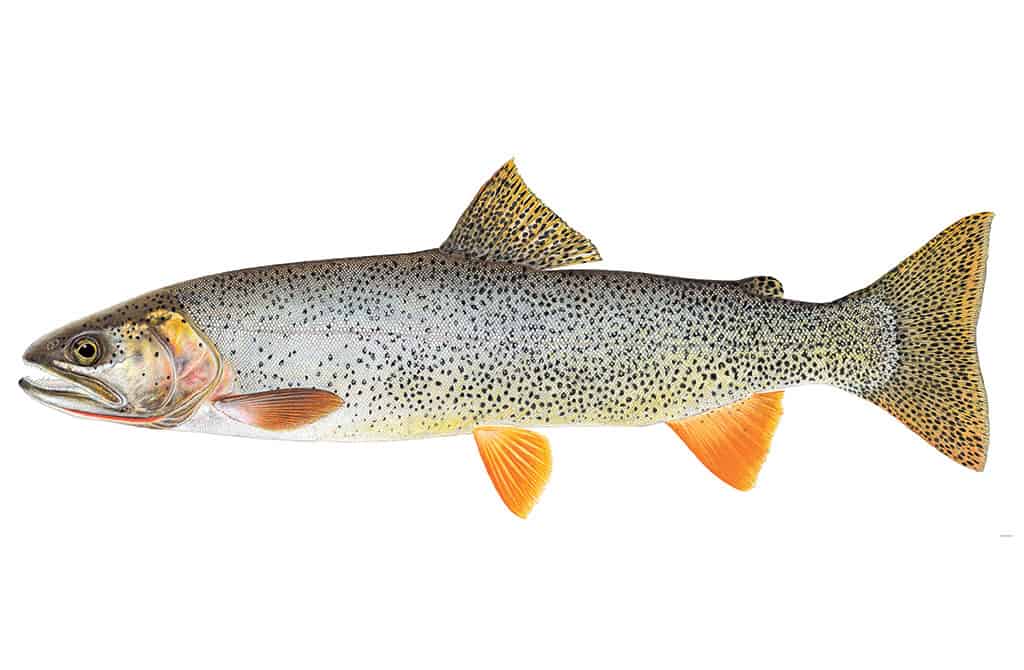Read The
Current Issue
The Cutt-Slam
Catch all four species of cutthroat trout native to Wyoming and you’ve got serious bragging rights.
By Caroline Markowitz
Illustration by Joe Tomelleri

Scientific name: Oncorhynchus clarki behnkei
Best places to catch: The Snake River and its primary tributaries—Fish and Flat creeks, and the Hoback, Gros Ventre, Salt, and Greys rivers
IT WAS 1996 when the late Ron Remmick, the Pinedale-area fisheries coordinator for Wyoming Game and Fish, came up with idea of the Cutt-Slam challenge. He wanted to educate anglers on the habitat requirements of cutthroat trout. True, cutthroat are not known as the most difficult of prey. Some local fishing guides refer to them as the “dumb blondes” of the trout world, but they’re such aggressive feeders only because of the harsh environment and short summers—our harsh environment and short summers—they’ve had to adapt to.
So what is the Cutt-Slam challenge? To complete it, anglers must catch all four federally recognized cutthroat subspecies in their native drainages: Colorado River Cutthroat, Bonneville Cutthroat, Snake River Cutthroat, and Yellowstone Cutthroat. Rob Gipson, G&F’s regional fisheries supervisor for the Snake River drainage, and the seventh fisherman to successfully complete the Cutt-Slam, back in 1997, says the aim isn’t the end result. “There’s not a time frame for completion,” Gipson says. “The whole concept is for anglers to understand that there are four different [cutthroat] subspecies in Wyoming. Catching all four is difficult because they’re so geographically separated.”
IN COMPLETING THE challenge, a component of fishing that’s typically lauded most—size—doesn’t matter. Spencer Morton, the founder of the Jackson Hole Fly Fishing School, says the Cutt-Slam is about much more than size. “Catching native cutthroat is special, because each subspecies of cutthroat originated from different drainages and has adapted to survive in each,” he says. Even though they all have their own drainages, the four subspecies are all “on the west.” This means they’re all located on the west side of Wyoming’s Continental Divide. Gipson estimates that a couple hundred anglers complete the Cutt-Slam annually.
The cutthroat trout is the only trout native to Wyoming. In terms of population, trout numbers aren’t low, but catching each subspecies in its native habitat is tricky. There’s one spot in the state where you can catch three of the four subspecies, the Tri-Basin Divide, in the Wyoming Range south of Jackson Hole. (You’ll still have to go to the Yellowstone River drainage for the Yellowstone cutthroat).
Even today, almost two decades after Gipson finished his Cutt-Slam, reminiscing about the experience brings a smile to his face. He keeps his Cutt-Slam certificate, the same certificate every angler who completes the challenge receives after submitting photographic proof of their catches to Game and Fish, hanging on his office wall. Gipson says, “I’ve talked to a lot of people who’ve completed the Cutt-Slam and everyone talks about how they had a really good time doing it.”
Find an interactive Cutt-Slam map at cuttslam.com/interactive-fishing-map.





